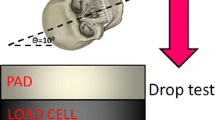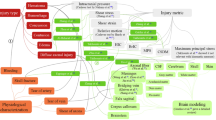Abstract
Background
The research paper emphasizes on virtual simulation of craniofacial skeleton to understand its Biomechanics.
Methods
In this study, a 3D finite element model of the skull was created using CT scan data. All complexities of the skull geometry are simulated using ABAQUS software. The model was validated and then, subjected to frontal impact. Energy plots for the same were obtained. Impact analysis was done, and weak areas susceptible to fracture and hence, failure are identified.
Results & Discussion
One of the emerging areas of applications of computational bio-mechanics is to understand the behavior of the skull during a traumatic injury, such as head impact during accidents. Finite element study is one such part where significant amount of research is being carried out to understand and predict the craniofacial injuries. For the head and brain trauma analysis, there are many software packages available, including ANSYS, LS-DYNA and ABAQUS. Research is being carried out towards developing high-fidelity human models, especially of the human skull to understand the bio-mechanical behavior when subjected to external impact. Impact analysis done in our study showed that a small change in impact velocity can result in a large change in damage that can happen.
Conclusion
The study is expected to complement the existing treatment methodologies. Further, appropriate knowledge of fracture biomechanics can be used to design and develop safety measures in automobiles, sport guards, helmets to prevent and reduce facial injuries.







Similar content being viewed by others
References
Kelly P, Crawford M, Kelly P, Crawford M, Higuera S, Hollier LH (2005) Two hundred ninety-four consecutive facial fractures in an urban trauma center: lessons learned. Plast Reconstructive Surg 116:42–49
Duma SM, Jernigan MV (2003) The effects of airbags on orbital fracture patterns in frontal automobile crashes. Ophth Plast Reconst Surg 19(2):107–111
Prado FB, Noritomi PY, Freire AR, Rossi AC, Neto FH, Caria PHF (2013) Stress distribution in human zygomatic pillar using three-dimensional finite element analysis. Int J Morphol 31(4):1386–1392
Torreira MG, Fernandez JR (2004) A three-dimensional computer model of the human mandible in two simulated standard trauma situations. J Cranio Max Fac Surg 32:303–307
Yoganandan N, Pintar FA (2004) Biomechanics of temporo-parietal skull fracture. Clin Biomech 19(3):225–239
Nagasao T, Miyamoto J, Shimizu Y, Jiang H, Nakajima T (2010) What happens between pure hydraulic and buckling mechanisms of blowout fractures? J Cranio Maxillofac Surg 38(4):306–313
Zhang J, Yoganandan N, Pintar FA (2009) PintarFA, Dynamic biomechanics of the human head in lateral impacts. Ann Adv Automot Med 53:249–256
Kumaresan S, Sances A Jr, Carlin F (2002) Biomechanical analysis of padding in child seats and head injury. Biomed Sci Instrum 38:453–458
Huempfner-Hierl H, Schaller A, Hierl T (2015) Maxillofacial fractures and craniocerebral injuries–stress propagation from face to neurocranium in a finite element analysis. Scand J Trauma Resusc Emerg Med 23(1):1–9
Yoganandan N, Pintar FA (1995) Biomechanics of skull fracture. J Neurotrauma 12(4):659–668
P. Federl and P. Prusinkiewicz: Finite element model of fracture formation on growing surfaces. In M. Bubak,G. van Albada, P. Sloot and J. Dongarra (Eds.): Proceedings of Computational Science. ICCS 2004 (Krakow, Poland, June 6−9, 2004), Part II, Lecture Notes in Computer Science 3037, Springer, Berlin, pp. 138–145.
Passeri LA, Ellis E, Sinn DP (1993) Complications of non-rigid fixation of mandibular angle fractures. J Oral Maxillofac Surg 51:382–384
Dr. Shobha E S1,Prof.Dr. H.P. Raghuveer, Dr. Suresh Nagesh, Vinay K S, International Journal of Engineering Research ,Volume No.4, Issue No.12, pp : 648–651.
Shobha ES, Nagesh S, Raghuveer HP, Vinay KS (2015) Analysis of stresses in mandible and skull under angular impact. Int J Eng Res 4(12):648–651
Rangan V, Raghuveer HP, Rayapati DK, Shobha ES, Prashanth NT, Sharma R (2013) The influence of stress distribution in four different fixation systems used in treatment of mandibular angle fractures—a three-dimensional finite element analysis. Oral Surg 6:186–192
Shobha ES, Raghuveer HP, Nagesh S, Vinay KS, Kumar RD, Prashanth NT, Rangan V (2016) Computational biomechanics in craniofacial fractures IEEE Explore, https://doi.org/10.1109/INDICON.2016.7838912
Author information
Authors and Affiliations
Corresponding author
Additional information
Publisher's Note
Springer Nature remains neutral with regard to jurisdictional claims in published maps and institutional affiliations.
Rights and permissions
Springer Nature or its licensor (e.g. a society or other partner) holds exclusive rights to this article under a publishing agreement with the author(s) or other rightsholder(s); author self-archiving of the accepted manuscript version of this article is solely governed by the terms of such publishing agreement and applicable law.
About this article
Cite this article
Shobha, E.S., Raghuveer, H.P., Nagesh, S. et al. Stress Propagation in the Craniofacial Skeleton on Frontal Impact—A Virtual Simulation Study. J. Maxillofac. Oral Surg. 22, 1027–1033 (2023). https://doi.org/10.1007/s12663-023-01979-4
Received:
Accepted:
Published:
Issue Date:
DOI: https://doi.org/10.1007/s12663-023-01979-4




